Market news & insights
Stay ahead of the markets with expert insights, news, and technical analysis to guide your trading decisions.

Most traders understand EA portfolio balance through the lens of traditional risk management — controlling position sizes, diversifying currency pairs, or limiting exposure per trade.
But in automated trading, balance is about deliberately constructing a portfolio where different strategies complement each other, measuring their collective performance, and actively managing the mix based on those measurements.
The goal is to create a “book” of EAs that can help diversify performance over time, even when individual strategies hit rough patches.
A diversified mix of EAs across timeframes and assets can, in some cases, reduce reliance on any single strategy. This approach reduces dependency on any single EA’s performance, smooths your overall equity curve, and builds resilience across changing market conditions.
It’s about running the right mix, identifying gaps in your coverage, and viewing your automated trading operation as an integrated whole rather than a collection of independent systems.
Basic Evaluation Metrics – Your Start Point
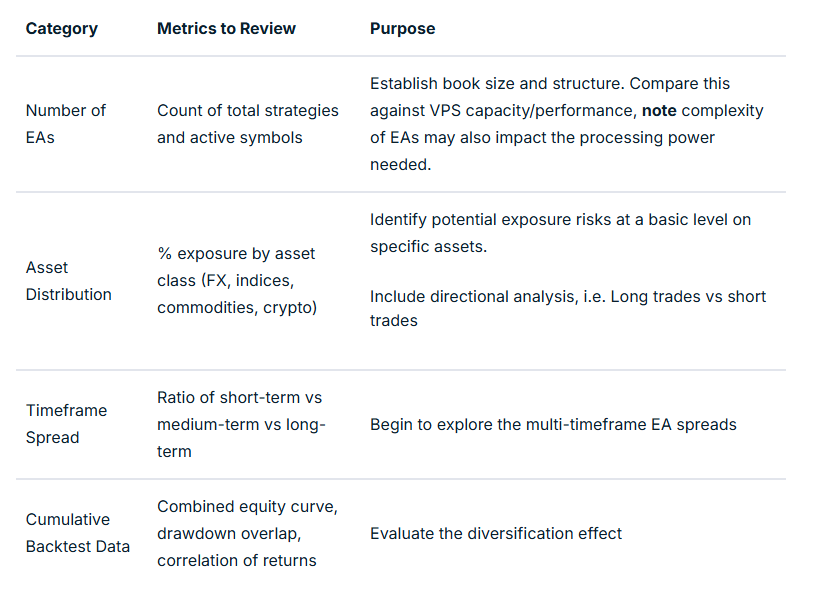
Temporal (timeframe) Balancing
When combined, a timeframe balance (even on the same model and instrument) can help flatten equity swings.
For example, a losing phase in a fast-acting M15 EA can often coincide with a profitable run in an H4 trend model.
Combining this with some market regime and sessional analysis can be beneficial.
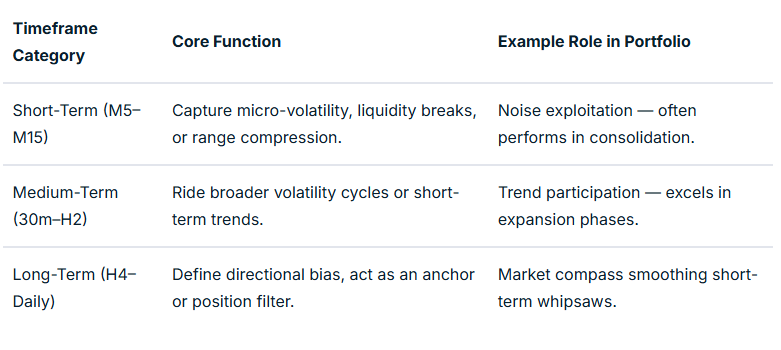
Asset Balance: Managing Systemic Correlation Risk
Running five different EAs on USDJPY might feel diversified if each uses different entry logic, even though they share the same systemic market driver.
But in an EA context, correlation measurement is not necessarily between prices, but between EA returns (equity changes) relating to specific strategies in specific market conditions.
Two EAs on the same symbol might use completely different logic and thus have near-zero correlation.
Conversely, two EAs on a different symbol may feel as though they should offer some balance, but if highly correlated in specific market conditions may not achieve your balancing aim.
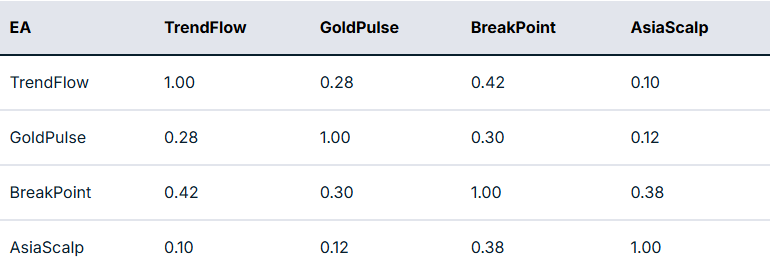
In practical terms, the next step is to take this measurement and map it to potential actionable interventions.
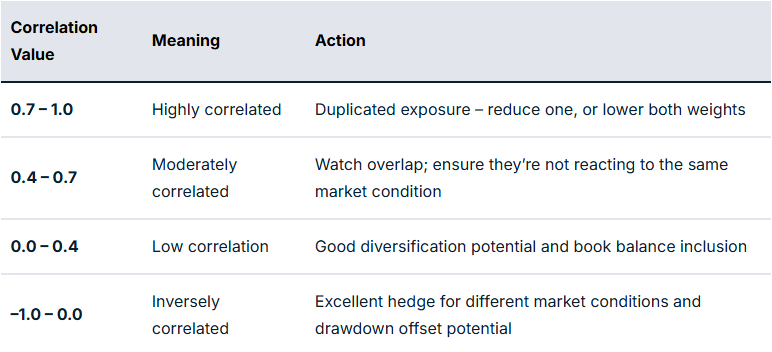
For example, if you have a EURUSD Trend EA and a GBPUSD Breakout EA with a correlation of 0.85, they are behaving like twins in performance related to specific market circumstances. And so you may want to limit exposure to some degree if you are finding that there are many relationships like this.
However, if your gold mean reversion EA correlates 0.25 compared to the rest of your book, this may offer some balance through reducing portfolio drawdown overlap.
Directional and Sentiment Balance
Markets are commonly described as risk-on or risk-off. This bias at any particular time is very likely to impact EA performance, dependent on how well balanced you are to deal with each scenario.
You may have heard the old market cliché of “up the staircase and down the elevator shaft” to describe how prices may move in alternative directions. It does appear that optimisation for each direction, rather than EAs that trade long and short, may offer better outcomes as two separate EAs rather than one catch-all.
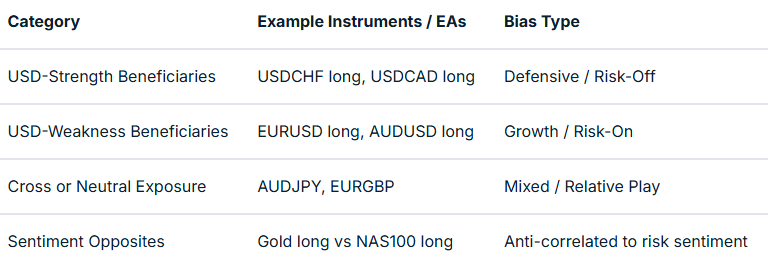
Market Regime and Volatility Balance
Trend and volatility states can have a profound impact on price action, whether as part of a discretionary or EA trading system. Much of this has a direct relationship to time of day, including the nature of individual sessions.
We have a market regime filter that incorporates trend and volatility factors in many EAs to account for this. This can be mapped and tested on a backtest and in a live environment to give evidence of strategy suitability for specific market conditions.
For example, mean reversion strategies may work well in the Asian session but less so in strongly trending markets and the higher volatility of the early part of the US session.
As part of balancing, you are asking questions as to whether you actually have EA strategies suited to different market regimes in place, or are you using these together to optimise book performance?
The table below summarises such an approach of regime vs market mapping:
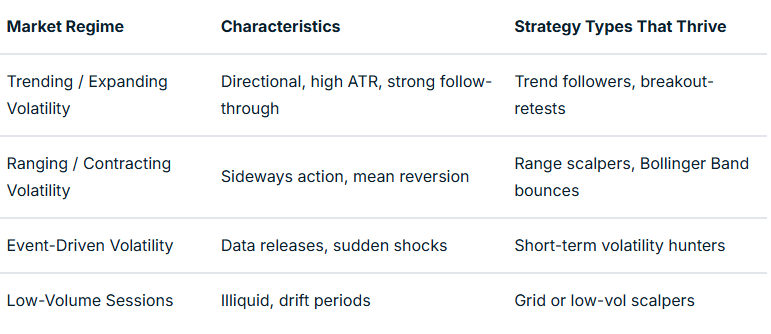
Multi-Level Analysis: From Composition to Interaction
Once your book is structured, the challenge is to turn it into something workable. An additional layer of refinement that turns theory and measurement into something meaningful in action is where any difference will be made.
This “closing the circle” is based on evidence and a true understanding of how your EAs are behaving together. It is the step that takes you to the point where automation can begin to move to the next level.
Mapping relationships with robust and detailed performance evaluation will take time to provide evidence that these are actually making a difference in meeting balancing aims.
To really excel, you should have systems in place that allow ongoing evaluation of the approaches you are using and advise of refinements that may improve things over time.
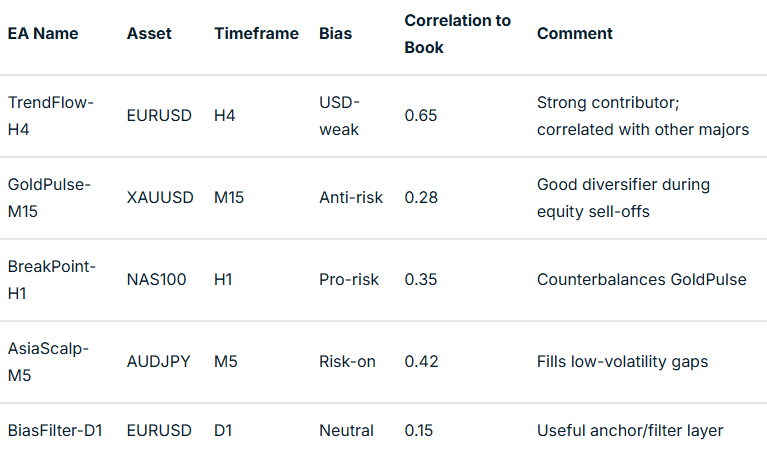
What Next? – Implementing Balance in Practice
Theory must ultimately translate into an executable EA book. A plan of action with landmarks to show progress and maintain motivation is crucial in this approach.
Defining classification tags, setting risk weights, and building monitoring dashboards are all worth consideration.
Advanced EA traders could also consider a supervisory ‘Sentinel’ EA, or ‘mothership’ approach, to enable or disable EAs dynamically based on underlying market metrics and external information integrated into EA coding decision-making.
Final Thoughts
A balanced EA portfolio is not generated by accident; it is well-thought-out, evidence-based and a continuously developing architecture. It is designed to offer improved risk management across your EA portfolio and improved trading outcomes.
Your process begins with mapping your existing strategies by number, asset, and timeframe, then expands into analysing correlations, directional bias, and volatility regimes.
When you reach the stage where one EA’s drawdown is another’s opportunity, you are no longer simply trading models but managing a system of EA systems. To finish, ask yourself the question, “Could this approach contribute to improved outcomes over time?”. If your answer is “yes,” then your mission is clear.
If you are interested in learning more about adding EAs to your trading toolbox, join the new GO EA Programme (coming soon) by contacting [email protected].


We have deliberately waited a few days before commenting on “Liberation Day” and the fallout that would come from President Trump’s new tariffs regime.It will go down as just another historical period of heightened volatility, uncertainty, risk, and a whole manner of market turmoil. This is why we wanted to put what is happening right now into some context. (If that is possible, considering how volatile the period is and how erratic and how quick the president's manner can change.)US markets have seen this kind of violent move only three times since the 1950s. The S&P’s over 10 per cent drop in the final two sessions of the week following President Trump's "Liberation Day" tariff announcement has it in rare company – and not in a good way - October 1987 (Black Monday), November 2008 (Global Financial Crisis), March 2020 (COVID-19).So, why such a reaction?The market reaction reflects not the ‘shock’ but the scale and brevity of the tariffs. A 10% across-the-board tariff was broadly expected. There were some calculations as much as 15 to 20% judging by the net $1 trillion in and out of the federal government revenue. (This is the impact of DOGE and other government spending cuts coupled with the tariffs now in place that will offset the promised 0% personal income tax for those earning up to US$150,000)But what markets didn’t see coming was the country-specific layer. Take China as an example; the additional 34% reciprocal tariff on Chinese goods pushed the total to 54%. With other measures factored in, the effective burden could approach 65%.Then there were the tariffs that were tied to trade deficits, hitting Japan, South Korea and most emerging markets between the eyes (i.e. Vietnam).The EU saw a 20% rate, which was within expectations, while the UK, Australia, New Zealand and others landed at 10%. Canada and Mexico were spared, as was Russia, North Korea and Belarus, interestingly enough.Energy was excluded, which is unsurprising considering Trump’s goal of getting energy down, down and staying down. Pharmaceuticals and semiconductors were also carved out, however, this is more down to the probability of more targeted action like that of steel and aluminium.Now, what is different about this market shock and risk off trading is that it would send funds flowing to the US dollar, ratcheting it higher. But not this time. The dollar weakened against the euro. Theories as to why range from Europe’s lighter tariff load to euro-based investors pulling money out of the US. The same could be said of the Swiss Franc.All this leads to an average effective tariff rate of around 22%. That number will likely climb once product-specific tariffs on areas like pharmaceuticals and lumber are formalised. Some of this may be negotiated down, but not soon, and the possibility of tit-for-tat retaliation like China has now entered into could actually see it going higher still as the President looks to outdo country responses.The broader uncertainty this introduces to the US outlook is now at its highest since early 2020 and has the markets pricing in 110 basis points of Fed rate cuts this year – a near 5 cut call shows just how unprecedented this is.In fact, in no time in living memory has a developed economy lifted trade barriers this aggressively or abruptly. What has been implemented is textbook economics 101 supply-side shock.Input costs go up, finished goods get pricier, and the ripple effects hit margins and employment. Expect to see this in the next six months.Expect core PCE inflation to finish the year at 3.5% —nearly a full percentage point higher than the consensus forecast from just a week ago.Real GDP growth is forecast to slow to 0.1% on a quarter-on-quarter basis. That path may be volatile as Q1 could look worse due to soft consumption and strong imports, with a mechanical bounce in Q2.What has been lost in the chaos of last Thursday and Friday’s trade was the March Non-farm payrolls jobs print came in at 228,000, which was above consensus, the caveat being it is less so after downward revisions to prior months.Hospitality hiring was strong, likely helped by a weather rebound that won’t repeat. Government payrolls are holding steady for now, but cuts are coming. Layoffs in defence and aerospace (DOGE) are already underway, and tariffs will act as a brake on new hiring. Expect softer reports ahead.Unemployment ticked up slightly to 4.15%, reflecting a modest rise in participation. That’s still within range, giving the Fed cover to hold off on immediate action. But if job losses build pressure on the Fed to act, it will increase quickly.The consensus now is for the first rate cut of this cycle to start in May, triggered by softer April payrolls and earlier signs of deterioration in jobless claims and business sentiment.Zooming out from just a US-centric point of view, the macro standpoint is just as bad if not worse. The scale of tariffs adds pressure on industrial production, trade volumes and cross-border investment.That’s feeding into commodity markets, where the outlook has turned more cautious.Brent is expected to fall into the low US$60s as trade frictions and oversupply build. LNG looks weaker too, with soft Asian demand and less urgency in Europe to restock. Iron ore is more exposed to China, and the reciprocal tariffs put a vulnerability into the price due to the broader global slowdown and higher prices to the US.Looking at China specifically, infrastructure remains a key policy lever that would offset the possible loss of demand in aluminium, copper, and steel. Monetary indicators are beginning to turn, suggesting the start of a new easing cycle. It also suggests that policy remains inward-facing, and a focus on domestic stability would mean a metals-heavy growth path. Thus suggesting Australia could be the ‘lucky country’ once more and could escape the full burden of the global upheaval.In short, the global reaction isn’t just about tariffs. It’s about what happens when policy shocks collide with already-fragile global demand, and central banks are forced to navigate inflation that’s driven by politics, not just price cycles.This is the question for traders and investors alike over the coming period.


In the world of trading, irrespective of what instrument or timeframes you are choosing to trade, losses aren't just inevitable—if you choose to embrace the opportunity they present, they also have the potential to be massively educational.According to studies from the Financial Industry Regulatory Authority, nearly 70% of retail traders experience significant losses within their first year of trading across all asset classes. Yet behind almost every successful trader's story, regardless of their market specialty, lies a narrative of devastating setbacks followed by remarkable recoveries.As Warren Buffett famously stated, "The most important quality for an investor is temperament, not intellect."In this article, where the current tariff-induced market shock is still very much on trader minds, we will look at how successful traders transform their losses—both in the contexts of everyday trading setbacks and catastrophic market shocks—into the foundation for their greatest comebacks.Clearly, although I am making some broad generalisations, the causative factors and response to loss will be unique to the individual trader. Your job when reading this is to “look in the mirror” and honestly appraise your losses and grab the elements of loss recovery that are a fit for you as a trader in whatever markets you choose to trade.The Psychology of Loss: Understanding Your Brain on Red NumbersWhen your portfolio turns red, your brain experiences a similar neurological response to physical pain. Neuroscience research has revealed that financial losses activate the same brain regions as physical threats, triggering fight-or-flight responses that can derail rational decision-making.The typical emotional cycle following a significant loss includes:
- Denial – "This is just a temporary pullback"
- Anger – "The market is rigged against retail traders"
- Bargaining – "If I can just get back to breakeven, I'll never make that mistake again"
- Depression – "Maybe I'm not cut out for trading"
- Acceptance – "This loss is now data I can use to improve"
While this cycle is natural, successful traders accelerate their journey to acceptance. As trader and author Mark Douglas writes, "The faster you can accept a loss, the quicker you can learn from it."Clearly the basis of this, and much of what is at the foundation of trading recovery, is “owning” your situation, taking responsibility for what has happened but also the chance to use this to create your trading future.The Post-Loss Analysis Framework: Turning Pain into DataRather than rushing to recover losses, elite traders first engage in systematic analysis. Here's a framework for transforming losses into actionable intelligence:
- Separate Market Factors from Execution Errors
Ask yourself: Was this loss due to unforeseeable market events or flaws in your execution? Categorising losses helps identify which elements were within your control. Of course, these are the things you can positively influence in future planning.For market factors: Document the specific conditions that led to the loss to recognise similar setups in the future.For execution errors: Break down each decision point where different choices could have mitigated the loss.
- Identify Emotional Triggers
Review your trading journal (if you don't keep one, start today, as anyone who has heard me teach will have heard before) to pinpoint emotional states that preceded poor decisions. Where any of these the case for you.
- Were you trading larger sizes after a series of wins?
- Did outside life stressors affect your focus?
- Were you trading out of boredom or FOMO?
- Were you unwell or have significant events outside of your trading?
I have spoken many times on the need to monitor your “trading state” with the ultimate sanction of course of temporarily removing yourself from trading or at least adapting your trading to account for any increased risk to optimum decision making in the heat of the market action.As Peter Lynch noted, "Know what you own, and know why you own it." This applies equally to understanding why you make certain trading decisions.
- Quantify Position Sizing Impact
Many devastating losses stem not from incorrect market analysis but inappropriate position sizing. Calculate how different position sizes would have affected the outcome:
- What would the loss have been at 25% of your actual position size?
- How would scaling in rather than entering all at once have changed the outcome?
- Did you violate your own risk management rules?
- Evaluate Your Original Trading Ideas
Revisit your original trading ideas and strategies with brutal honesty:
- What evidence supported your idea?
- What contradictory signals did you ignore?
- Was your time frame appropriate for the setup?
Remember Buffett's wisdom: "When you find yourself in a hole, stop digging." Recognising when a (trading) thesis is invalidated is as important as forming one.Having said this, this does play into the narrative that the major influence is all about entry. Invariably, and as many experienced traders will recognise, it is as much about exits. Ask yourself similar questions about YOUR exits such as:
- What evidence supported your decision to stay?
- What contradictory signals did you ignore that were suggestive it may have been technically or fundamentally prudent to get out?
- Did I get greedy and see a win disappear and turn into a loss because my exits didn’t account for changing market conditions.
Navigating Market Shocks: When Everyone PanicsWhile individual trading losses are challenging, market-wide shocks present unique recovery challenges across all trading vehicles. Events like the 2008 financial crisis, the March 2020 COVID crash, or the 2022 tech sector collapse create systemic disruptions in stocks, forex, commodities, cryptocurrency, and futures markets alike. These cross-asset dislocations require specific recovery strategies that work regardless of what you trade.Phase 1: Survival ModeWhen markets experience shock events, liquidity often disappears precisely when you need it most. During these periods:
- Reduce position sizes by 50-75% until volatility normalizes
- Increase cash reserves to capitalize on opportunities when stability returns
- Identify which assets are experiencing liquidity crises versus fundamental revaluations
As Ray Dalio explains, "The biggest mistake investors make is to believe that what happened in the recent past is likely to persist."Phase 2: Opportunity AssessmentMarket shocks create dislocations between price and value across all asset classes. Once the initial panic subsides:
- Look for quality assets trading at distressed prices, whether they're currencies, commodities, cryptocurrencies, or traditional securities
- Identify market segments experiencing forced selling rather than fundamental deterioration
- Analyse historical recovery patterns from similar market events across your specific trading vehicles
Although these principles are often applied to stocks, this same may be equally relevant to selecting specific currencies, commodities, or cryptos that show strength during recovery phases.Signs a Market Shock Is SubsidingRecognising when a market shock is ending is crucial for timing your re-entry. Look for these cross-asset indicators:
- Volatility Normalization: When instruments like the VIX for stocks, MOVE index for bonds, or historical volatility metrics for forex and crypto begin trending downward consistently over multiple sessions.
- Volume Patterns: Panic selling typically peaks with extraordinary volume. When volume returns to more normal levels while prices stabilize, the acute phase of the shock may be ending.
- Correlation Breakdown: During shocks, correlations across assets approach 1.0 as "everything moves together." When correlations begin normalizing and assets resume individual price paths, recovery may be underway.
- Institutional Positioning: When the commitment of traders (COT) reports, fund flow data, or whale wallet movements (in crypto) show smart money beginning to accumulate, the worst may be over.
- Media Sentiment Shift: When mainstream financial headlines shift from panic to "bargain hunting" or "value spotting," sentiment may be improving.
Phase 3: Strategic Re-entryRe-entering the market after a shock requires methodical execution, regardless of what you trade:
- Start with small positions (25% of your normal size) whether you're trading equity indices, currency pairs, commodity futures, or cryptocurrencies
- Scale in gradually over weeks or months rather than days, adapting the timeframe to the typical volatility cycle of your specific market
- Prioritize liquid instruments with tight spreads—major forex pairs over exotics, large-cap stocks over small caps, bitcoin over microcaps, front-month futures over back months
- Set defined markers for increasing exposure that make sense for your trading vehicle (e.g., "When VIX drops below 25, I'll increase stock position sizes by 15%" or "When 30-day realized volatility in EUR/USD returns to pre-crisis averages, I'll increase forex exposure by 20%")
- And of course, begin to put in place some of the lessons you have learned from your evaluation as to what you could have done differently. To go back to the same again is unlikely to serve you well.
Risk Management 2.0: The Post-Loss EditionRecovering from significant losses demands refined risk management, regardless of which markets you trade. Consider implementing these cross-asset approaches:The 2% Recovery RuleUntil you've recovered psychologically and financially from major losses, limit each trade's risk to 1% of your current account size—not your pre-loss portfolio.This prevents the common mistake of trying to "get it all back at once." This principle works whether you're trading corn futures, Japanese yen, technology stocks, or Bitcoin. Traders often make the mistake of using different risk parameters across different markets, but during recovery, consistency in risk approach is crucial.For leveraged instruments like futures and forex, this means being especially vigilant about effective position sizing. A 2% account risk in a 50:1 leveraged forex position requires much smaller position sizing than the same risk level in an unleveraged stock position.The 3-Strike System – the potential to work your way back into markets whilst managing a potential “aftershock”After a significant loss, implement a three-strike system for any new position, adapting for your market's characteristics:
- Enter with 30% of the intended position. In markets with defined seasonal tendencies like commodities, this initial entry might align with historical inflection points. In more technical markets like forex, this might coincide with key support/resistance levels.
- Add 30% only if the position moves in your favour by a predetermined amount calibrated to your market's typical volatility. For a stock index, this might be 1-2%; for cryptocurrencies, perhaps 5-8%; for treasury futures, maybe just 0.5%.
- Add the final 40% only after a key technical level confirms your entry idea. The nature of this confirmation varies—options traders might look for specific implied volatility behaviour, while futures traders might focus on volume confirmation patterns.
- AND, of course, manage profit risk as you go with potentially staged exits.
This systematic approach prevents emotional overcommitment while providing multiple decision points to evaluate your analysis, whether you're trading energy futures, currency pairs, or equity options.Drawdown Recovery CalculationTo determine how long recovery might take, use this formula, which applies across all trading vehicles:Recovery Time = (Loss Percentage ÷ Expected Monthly Return) × 1.5The Comeback Plan: Rebuilding With IntentionRecovery isn't merely about regaining lost capital—it's about rebuilding a more robust trading approach. Your comeback plan should include:
- Psychological Reset
Taking a complete psychological reset is essential after significant losses. Step away from all trading activities for at least one week following major drawdowns. This isn't merely about taking a break—it's about creating the mental space necessary for objective analysis. During this period, deliberately engage in activities entirely unrelated to markets to refresh your cognitive resources and perspective.Many successful traders report that their best insights about market behaviour come when they've mentally detached. Whether you trade forex, futures, options, or any other instrument, the psychological impact of losses affects your decision-making in similar ways. Practice visualization exercises daily during this reset period, imagining calm, methodical responses to future setbacks across various scenarios relevant to your particular trading vehicles.
- Skills Development
Identify specific skills that could have prevented or mitigated your losses, tailored to your trading approach:If technical analysis has failed you in forex markets, consider strengthening your understanding of interest rate differentials and monetary policy influences. For crypto traders, this might mean better on-chain analysis skills. For options traders, it could mean improving your volatility forecasting methods.If position sizing is the issue, study risk management methodologies specific to your trading vehicle. Futures and forex traders might focus on improved margin utilization techniques, while options traders might explore better ways to size positions relative to implied volatility.If emotional control was lacking, explore mindfulness practices specifically for traders. Regardless of what you trade, the psychological demands remain similar—develop routines that work for your trading style and personality. Many successful traders across all market types report benefits from meditation, journaling, or working with trading coaches who understand the psychological dimensions of their specific markets.
- Confidence Rebuilding Through Small Wins
The path back to confidence works similarly whether you trade agricultural futures, exotic currency pairs, or growth stocks. Start with trades that have:High probability setups that match historical patterns in your specific market. For commodity traders, this might mean well-defined seasonal patterns; for forex traders, clear support/resistance levels with confirming indicators.Limited downside with predefined maximum loss levels appropriate to the volatility of your trading instrument. A 2% stop might be reasonable for a stock position but entirely too tight for a cryptocurrency trade.Clear exit criteria that are written down before entry and respected regardless of how the trade develops. Different markets require different exit strategies—trailing stops may work well in trending commodity markets but fail in choppy forex conditions.Focus on building a streak of small victories rather than recovering losses immediately. Trading confidence is rebuilt through consistency, not home runs. This principle applies whether you day trade S&P futures or swing trade altcoins. The psychological value of consecutive wins far outweighs their monetary value during the recovery phase.
- Progressive Scaling
Establish clear metrics for when to increase position sizes, customized to your trading vehicle:After 10 consecutive profitable trades, increase the size by 10%, but only if those trades were representative of your normal strategy across different market conditions. For options traders, this means profitability across both low and high volatility environments; for forex traders, it means success in both trending and ranging markets.After reaching 50% of drawdown recovery, revisit normal position sizing, but with additional safeguards based on lessons learned. This might mean using options to hedge spot positions, implementing correlation-based position sizing in your portfolio, or using volatility-adjusted position sizing in highly variable markets like cryptocurrencies.After demonstrating consistent profitability for three months across diverse market conditions relevant to your trading vehicles, return to standard trading parameters. This time frame allows for testing your refined approach through different market regimes, whether you trade indices, energies, metals, or digital assets.Perspective From the Masters: Wisdom After LossesThe greatest traders all share stories of devastating losses followed by tremendous comebacks. Their perspective can often offer invaluable guidance as well as encouragement:
- "I'm only rich because I know when I'm wrong. I basically have survived by recognizing my mistakes." — George Soros
- "There is nothing like losing all you have in the world for teaching you what not to do." — Warren Buffett
- "The elements of good trading are cutting losses, cutting losses, and cutting losses." — Ed Seykota
- "Being wrong is acceptable, but staying wrong is totally unacceptable." — Paul Tudor Jones
Conclusion: The Paradox of LossPerhaps the most counterintuitive truth about trading is that losses—properly processed—are potentially the foundation of long-term success. They provide the feedback necessary to refine strategies, strengthen discipline, and develop the psychological resilience required for sustained performance.Of course, such potential is only the case should you choose to take appropriate actions.As you face your next loss, whether from an individual position or a market-wide shock, remember that your response to that loss—not the loss itself—will ultimately determine your trading trajectory.The path from setback to comeback isn't merely about recouping capital -- it's about emerging with enhanced skills, refined processes, and the unshakable confidence that comes from navigating difficult markets.Trading losses aren't failures, they are feedback—consider them tuition payments for lessons that, once truly learned, can never be taken from you.


IntroductionIn the world of trading, "poor discipline" is frequently cited as the downfall of many aspiring and even experienced traders. It's the convenient explanation when trades go wrong: "I just need more discipline." However, this perspective misses a crucial insight—poor trading discipline is rarely the root problem. Rather, it's a symptom of deeper underlying issues that, if left unaddressed, will continue to manifest in trading behaviours that undermine success.This article explores why poor discipline should be viewed as a warning sign rather than the primary diagnosis and why identifying the true root causes is essential for lasting behavioural improvement in trading performance.The Real Cost of Poor Trading DisciplineBefore diving into the underlying causes, let's examine why addressing poor discipline is so critical by looking at its tangible and intangible costs:Financial Costs
- Direct monetary losses: Impulsive entries, failure to cut losses, and premature profit-taking all directly impact returns. For example, a trader who consistently moves their stop loss to avoid small losses often ends up with catastrophic drawdowns when positions move strongly against them.
- Compounding opportunity loss: Small discipline breaches compound dramatically over time. Consider a portfolio that takes a 20% loss from failure to exit a bad position—this now requires a 25% gain just to break even, pushing the recovery timeline significantly further. Over decades of trading, these setbacks can reduce final portfolio values by millions of dollars.
- Transaction costs accumulation: Overtrading from lack of discipline increases commissions and fees, creating a significant drag on performance. A trader who churns their account with 30 trades monthly instead of 10 well-planned entries might see 2-3% annual returns evaporate in transaction costs alone.
Psychological Costs
- Eroded confidence: Repeated discipline failures create self-doubt that bleeds into all trading decisions. When a trader has broken their rules multiple times, they begin to question their judgment even on valid setups. One trader described it as: "After three consecutive discipline breaches, I started second-guessing even my most high-probability trades, missing several winners that matched my criteria perfectly."
- Decision fatigue: The mental energy expended fighting poor impulses depletes cognitive resources needed for analysis. Studies show that willpower and decision-making ability diminish throughout the day when constantly tested. A trader fighting urges to deviate from their plan has less mental bandwidth for analysing market conditions or spotting opportunities.
- Emotional damage: The stress and anxiety from undisciplined trading can lead to burnout and abandonment of trading altogether. Many professional traders report that their worst losing streaks weren't caused by market conditions but by their emotional responses to initial losses, creating a downward spiral of poor decisions.
Strategic Costs
- Invalidated testing: Even the best trading strategies become untestable when executed inconsistently. When a trader backtests a strategy showing 60% win rate and 1:2 risk/reward ratio but then implements it inconsistently—perhaps holding losers too long or cutting winners short—the actual performance bears no resemblance to the expected results, making further optimization impossible.
- Misattributed failures: When discipline issues cloud results, traders often blame their strategy rather than their execution. A common scenario: a trader abandons a perfectly viable strategy because "it doesn't work," when in reality, they never truly followed the strategy's rules in the first place.
- Stunted development: Traders stuck in discipline loops rarely advance to higher-level trading concepts and strategies. Instead of progressing to sophisticated risk management, portfolio theory, or advanced market analysis, they remain trapped in the cycle of "discover strategy → implement poorly → abandon strategy → repeat."
Root Causes of Poor Trading DisciplinePoor discipline manifests in many ways—impulsive trades, inability to follow rules, emotional decision-making—but these behaviours stem from deeper sources. Let's examine the most common underlying causes:
- Misalignment Between Strategy and Psychology
- Risk tolerance mismatch: Trading with position sizes that trigger outsized emotional responses. For example, a trader comfortable with 0.5% risk per trade suddenly increases to 5% risk and finds themselves unable to follow their rules under the heightened pressure. One professional trader noted: "When I exceeded my natural risk threshold, even temporary drawdowns caused me to abandon my tested methods and make emotional decisions."
- Personality-strategy disconnect: Using trading approaches that conflict with natural psychological tendencies. A detail-oriented, methodical person might struggle with discretionary price action trading but excel with systematic, rules-based approaches. Conversely, intuitive, big-picture thinkers often feel constrained by highly mechanical systems and may unconsciously seek to override them.
- Time frame incompatibility: Trading time frames that don't match one's lifestyle, attention span, or stress tolerance. A parent with young children attempting to day trade during family hours will likely experience constant interruptions and stress, leading to impulsive decisions. Alternatively, someone with a high need for action and feedback might struggle with position trading where trades take weeks to unfold, leading to overtrading or premature exits.
- Knowledge and Preparation Gaps
- Inadequate planning: Trading without clearly defined entries, exits, and risk parameters. Consider a trader who enters a position based on a promising chart pattern but has no predetermined exit strategy—when the trade moves against them, they're forced to make decisions under pressure, often resulting in poor outcomes. A complete trading plan would specify: "Enter long at $X if Y condition is met, with stop loss at $Z (1% risk) and first target at 2R with trailing stop."
- Statistical misunderstanding: Failure to grasp the probabilistic nature of trading and proper expectancy. Many traders cannot emotionally handle normal losing streaks because they don't understand that even a strategy with a 65% win rate can easily produce 5-6 consecutive losses. Without this understanding, they abandon strategies prematurely or make modifications at exactly the wrong time.
- Incomplete strategy validation: Using approaches that haven't been thoroughly tested, creating doubt during execution. A trader who implements a strategy based on a few examples or back-of-napkin calculations lacks the confidence that comes from rigorous testing across different market conditions. This uncertainty breeds hesitation and second-guessing when real money is on the line.
- Cognitive and Emotional Factors
- Cognitive biases: Succumbing to confirmation bias, recency bias, and other thinking errors. For instance, a trader who has had two successful trades in the tech sector might overweight recent positive experiences and ignore risk factors when evaluating the next tech opportunity. Another common example is the gambler's fallacy—believing that after a string of losses, a win is "due," leading to oversized bets at precisely the wrong time.
- Identity attachment: Tying self-worth too closely to trading outcomes. When being right becomes a matter of personal validation rather than a probabilistic outcome, traders defend losing positions rather than accepting small losses. One reformed trader shared: "I realized I was viewing each trade as a referendum on my intelligence. Once I separated my self-image from my P&L, I could finally follow my stop-loss rules consistently."
- Unresolved psychological issues: Using trading as an outlet for excitement, validation, or escape. Some individuals trade to experience the thrill of risk rather than to execute a business plan, making discipline inherently difficult. Others use trading to escape boredom or dissatisfaction in other life areas, creating an emotionally charged environment where clear thinking is compromised.
- Environmental and Contextual Elements
- Financial pressure: Trading with needed living expenses or under external performance expectations. A trader who depends on monthly trading profits to pay bills faces enormous psychological pressure, making it difficult to maintain discipline during inevitable drawdowns. Similarly, someone trading family money or with partners looking over their shoulder may feel pressure to perform which leads to overtrading or excessive risk-taking.
- Inappropriate trading environment: Working in distracting or emotionally charged settings. The trader attempting to make decisions while monitoring multiple news sources, social media, and chat rooms is bombarded with information that triggers fear of missing out or fear of loss. Physical environment matters too—one hedge fund manager requires his traders to maintain clean, organized desks, finding that physical disorder correlates with mental disorder in trading decisions.
- Lack of accountability: Absence of mentorship, trading journals, or other feedback mechanisms. Trading in isolation without systematic review processes allows small discipline breaches to go unnoticed and uncorrected until they become habitual. A professional prop trader described their turnaround: "Everything changed when I started recording every trade with my reasoning before and after. Patterns of undisciplined behaviour became obvious, and I couldn't hide from them anymore."
The Path to Improved Trading DisciplineTrue improvement in trading discipline requires addressing root causes rather than symptoms:Self-Assessment and Awareness
- Conduct a thorough inventory of trading behaviours, noting patterns of discipline breaches. Review at least 100 recent trades, looking specifically for instances where you deviated from your stated rules. Categories might include moving stop losses, increasing position sizes after losses, trading outside planned hours, or ignoring pre-trade checklists.
- Identify emotional triggers that precede discipline lapses. Common triggers include consecutive losses, approaching monthly profit targets, trading during personal stress, or trading after reading market opinions that conflict with your analysis. One trader discovered that 70% of his discipline breaches occurred after checking his month-to-date performance, leading him to remove this information from his trading screen.
- Honestly evaluate whether your trading approach aligns with your personality and circumstances. Ask whether your chosen time frame matches your availability and temperament, whether your risk per trade truly feels comfortable, and whether your strategy's complexity level matches your analytical tendencies.
Targeted Interventions
- For strategy misalignment: Adjust position sizing, time frames, or trading style to better match your psychological makeup. A trader struggling with day trading's intensity might find swing trading more sustainable. Someone uncomfortable with discretionary decisions might adopt a fully systematic approach with clearly defined rules. Position sizing adjustments—often reducing size until emotional responses diminish—can be transformative.
- For knowledge gaps: Create comprehensive trading plans and enhance statistical understanding. Develop detailed playbooks for every scenario: entry conditions, initial stops, how to trail stops, when to add to positions, and multiple exit scenarios. Study probability and statistics to build confidence in your strategy's long-term expectancy despite short-term variance. One trader reported: "Understanding that 7 consecutive losses with my 65% win rate strategy had a 0.4% probability—rare but entirely normal—freed me from panic during losing streaks."
- For cognitive/emotional factors: Develop mindfulness practices and consider working with a trading coach. Regular meditation or breathing exercises before trading sessions can reduce emotional reactivity. Trading coaches who specialise in psychological aspects can identify blind spots and provide objective feedback. Some traders benefit from visualization exercises, mentally rehearsing and maintaining discipline through challenging scenarios before they occur.
- For environmental issues: Create a dedicated trading space and establish clear boundaries around trading capital. Physically separate trading from other activities with a dedicated workspace free from distractions. Financially separate trading capital from living expenses with at least 12 months of expenses in separate accounts. Develop protocols for communication with spouses or partners about trading results to reduce external pressure.
Systems and Guardrails
- Implement technological solutions to enforce discipline. Use broker platforms that allow automated stop losses that cannot be modified once set. Create custom alerts that flag when you're exceeding daily trade count limits or risk thresholds. One options trader programmed his platform to prevent opening new positions after 2pm when his historical data showed decreased decision quality.
- Create decision trees that remove in-the-moment choices during emotional market periods. Develop if-then contingency plans for various market scenarios: "If price breaks support level X, then I will execute plan Y without hesitation." Pre-commitment to specific actions reduces the cognitive burden during high-stress periods.
- Establish pre-commitment mechanisms that make discipline breaches more difficult. This might include trading with a partner who must approve stop-loss modifications, scheduling accountability calls with mentors after trading sessions or creating financial penalties for rule violations that are donated to charity. One creative trader set up an arrangement where breaking specific rules required him to make a substantial donation to a political cause he opposed—a powerful deterrent!
ConclusionPoor trading discipline is rarely just about willpower or character. By recognizing discipline problems as symptoms pointing to deeper causes, traders can address the true sources of their trading difficulties. This approach not only improves immediate trading performance but creates sustainable behavioural change that can transform trading results over the long term.Rather than berating yourself for discipline failures, use them as valuable data points that highlight areas needing attention in your trading psychology, knowledge, strategy, or environment. When these foundational elements are aligned, discipline becomes less of a struggle and more of a natural expression of a well-designed trading approach.The most successful traders understand that consistent discipline isn't achieved through force of will but through creating circumstances where disciplined behaviour is the path of least resistance. By addressing root causes rather than symptoms, they develop trading approaches that work with—rather than against—their natural tendencies, leading to sustainable success in the markets.
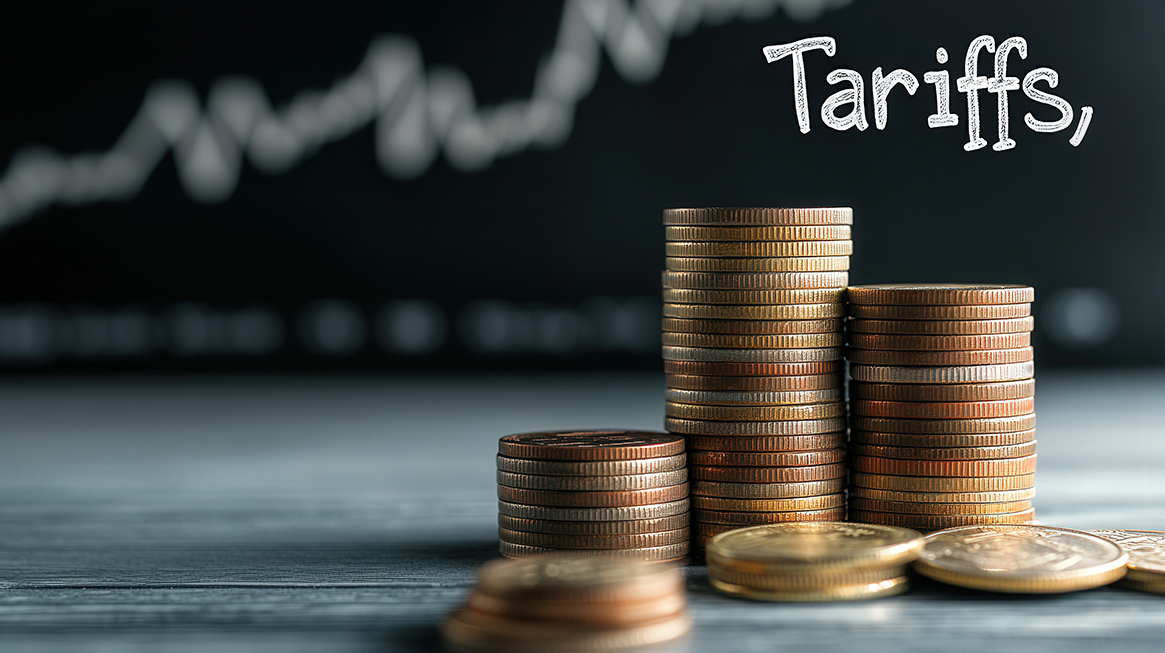

We would suggest that right now Markets are underestimating the impact of April 2 US Reciprocal Tariffs – aka Liberation Day monikered by the President.There is consistent and constant chatter around what is being referred to as The Dirty 15. This is the 15 countries the president suggests has been taking advantage of the United States of America for too long. The original thinking was The Dirty 15 for those countries with the highest levels of tariffs or some form of taxation system against US goods. However, there is also growing evidence that actually The Dirty 15 are the 15 nations that have the largest trade relations with the US.That is an entirely different thought process because those 15 countries include players like Japan, South Korea, Germany, France, the UK, Canada, Mexico and of course, Australia. Therefore, the underestimation of the impact from reciprocal tariffs could be far-reaching and much more destabilising than currently pricing.From a trading perspective, the most interesting moves in the interim appear to be commodities. Because the scale and execution of US’s reciprocal tariffs will be a critical driver of commodity prices over the coming quarter and into 2025.Based on repeated signals from President Trump and his administration, reinforced by recent remarks from US Commerce Secretary Howard Lutnick. Lutnick has indicated that headline tariffs of 15-30% could be announced on April 2, with “baseline” reciprocal tariffs likely to fall in the 15-20% range—effectively broad-based tariffs.The risk here is huge: economic downturn, possibilities of hyperinflation, the escalation of further trade tensions, goods and services bottlenecks and the loss of globalisation.This immediately brings gold to the fore because, clearly risk environment of this scale would likely mean that instead of flowing to the US dollar which would normally be the case the trade of last resort is to the inert metal.The other factor that we need to look at here is the actual end goal of the president? The answer is clearly lower oil prices—potentially through domestic oil subsidies or tax cuts—to offset inflationary pressures from tariffs and to force lower interest rates.‘Balancing the Budget’Secretary Lutnick has specified that the tariffs are expected to generate $700 billion in revenue, which therefore implies an incremental 15-20% increase in weighted-average tariffs. We can’t write off the possibility that the initial announcement may set tariffs at even higher levels to allow room for negotiation, take the recently announced 25% tariffs on the auto industry. From an Australian perspective, White House aide Peter Navarro has confirmed that each trading partner will be assigned a single tariff rate. Navarro is a noted China hawk and links Australia’s trade with China as a major reason Australia should be heavily penalised.Trump has consistently advocated for tariffs since the 1980s, and his administration has signalled that reciprocal tariffs are the baseline, citing foreign VAT and GST regimes as justification. This suggests that at least a significant portion of these tariffs may be non-negotiable. Again, this highlights why markets may have underestimated just how big an impact ‘liberation day’ could have.Now, the administration acknowledges that tariffs may cause “a little disturbance” (irony much?) and that a “period of transition” may be needed. The broader strategy appears to involve deficit reduction, followed by redistributing tariff revenue through tax cuts for households earning under $150K, as reported by the likes of Reuters on March 13.The White House has also emphasised a focus on Main Street over Wall Street, which we have highlighted previously – Trump has made next to no mention of markets in his second term. Compared to his first, where it was basically a benchmark for him.All this suggests that some downside risk in financial markets may be tolerated to advance broader economic objectives.Caveat! - a policy reversal remains possible in 2H’25, particularly if tariffs are implemented at scale and prove highly disruptive and the US consumer seizes up. Which is likely considering the players most impacted by tariffs are end users.The possible trades:With all things remaining equal, there is a bullish outlook for gold over the next three months, alongside a bearish outlook on oil over the next three to six months.Gold continues to punch to new highs, and its upward trajectory has yet to be truly tested. Having now surpassed $3,000/oz, as a reaction to the economic impact of tariffs. Further upside is expected to drive prices to $3,200/oz over the next three months on the fallout from the April 2 tariffs to come.What is also critical here is that gold investment demand remains well above the critical 70% of mine supply threshold for the ninth consecutive quarter. Historically, when investment demand exceeds this level, prices tend to rise as jewellery consumption declines and scrap supply increases.On the flip side, Brent crude prices are forecasted to decline to $60-65 per barrel 2H’25 (-15-20%). The broader price range for 2025 is expected to shift down to $60-75 per barrel, compared to the $70-90 per barrel range seen over the past three years.Now there is a caveat here: the weak oil fundamentals for 2025 are now widely known, and the physical surplus has yet to materialise – this is the risk to the bearish outlook and never write off OPEC looking to cut supply to counter the price falls.


Introduction in the constant pursuit of market edge, traders often find themselves crowded into the same analytical spaces, watching identical indicators and acting on similar signals. This collective attention of market participants potentially creates a paradox: the more traders follow conventional signals, the less effective these signals become. While price action, volume, moving averages, and oscillators dominate trading screens worldwide, beneath the visible surface of market activity lies a rich ecosystem of "silent indicators" that often telegraph significant moves long before they materialize in price.
The financial markets do not exist as isolated entities for specific assets but rather as an interconnected web where currencies influence commodities, bonds telegraph equity movements as obvious examples. Understanding these cross-market relationships enables traders to assemble a more complete market picture and recognise the early warning signs that often precede major moves. This is not an exhaustive list but aims to cover some of the key factors that also offer an opportunity of accessibility for the retail trader.
I have suggested some sources that may be useful. This article explores these potentially overlooked signals across multiple asset classes, providing traders with a framework to identify market shifts before they become apparent to the majority. Section 1: Institutional Footprints Volume Profile Analysis Core Concept: Volume profile analysis examines how trading volume distributes across price levels rather than just time periods, revealing where significant transactions occurred and potentially where institutional interest exists.
Point of Control Significance: The price level with the highest trading volume (Point of Control) often acts as a magnet during future trading sessions, as this represents the price where most transactions were agreed upon. Volume Nodes and Gaps: Areas with sparse trading volume often become "vacuum zones" where price can move rapidly when entered, while high-volume nodes frequently act as support/resistance. Retail-Accessible Sources: TradingView Volume Profile indicator (free/premium) Sierra Chart volume profile tools (subscription) Tradovate volume profile tools (subscription) Open Interest Changes in Futures and Options Core Concept: Open interest represents the total number of outstanding contracts in derivatives markets.
Changes in open interest, when combined with price movement, provide insights into whether new money is entering a trend or positions are being closed. Confirmation Signals: Rising prices with rising open interest confirms bullish momentum (new buyers entering); falling prices with rising open interest confirms bearish momentum (new sellers entering). Warning Signals: Rising prices with falling open interest suggests a weakening trend (shorts covering); falling prices with falling open interest suggests a weakening downtrend (longs liquidating).
Options Open Interest Concentration: Unusual accumulation of open interest at specific strike prices often indicates institutional positioning and can create price magnets or barriers. Retail-Accessible Sources: CME Group open interest data (free) TradingView futures open interest indicators (free/premium) Barchart.com options open interest data (free/premium) CBOE options volume and open interest (free) Commitment of Traders Analysis Core Concept: The Commitment of Traders (COT) report breaks down the holdings of different trader categories (commercial, non-commercial, small speculators) in futures markets, revealing how different market participants are positioned. Commercial vs.
Speculator Divergence: When commercial hedgers (smart money) and speculators (often trend-followers) show extreme position differences, it often signals potential market turning points. Historically Significant Extremes: Comparing current positioning to historical extremes provides context—when any group reaches unusual net long or short positions, mean reversion often follows. Multi-Market Applications: COT data covers currencies, commodities, bonds, and equity index futures, allowing for cross-market analysis and early warning of sentiment shifts.
Retail-Accessible Sources: CFTC COT reports (free, weekly) Investing.com COT data visualizations (free) BarcChart.com COT charts (free/premium) TradingView COT indicators (community scripts, free) Section 2: Sentiment Indicators Beyond the Headlines Market Internals Across Asset Classes Core Concept: Market internals measure the underlying strength or weakness of a market beyond just the headline index price. These include advance-decline lines, new highs vs. new lows, and percentage of assets above moving averages. Breadth Divergences: When market indices make new highs while internals weaken (fewer stocks participating in the advance), it often signals deteriorating market health before price confirms.
Confirming Strength: Strong internals during consolidations or minor pullbacks often indicate underlying buying pressure and increase the probability of continuation. Cross-Asset Applications: This concept applies beyond stocks—measuring the percentage of commodities in uptrends, currencies strengthening against the dollar, or global markets above their moving averages provides comprehensive market health metrics. Retail-Accessible Sources: StockCharts.com market breadth indicators (free/subscription) TradingView breadth indicators (free/premium) Investors.com market pulse data (subscription) DecisionPoint breadth charts (StockCharts subscription) Retail vs.
Institutional Sentiment Divergence Core Concept: When retail traders' sentiment significantly diverges from institutional positioning, the smart money view typically prevails. This divergence creates opportunities for contrarian traders. Retail Sentiment Gauges: Social media sentiment, trading app popularity rankings, and retail-focused brokerage positioning data reveal retail trader enthusiasm.
Institutional Positioning Clues: Fund flow data, professional survey results, and positioning metrics from prime brokers indicate institutional sentiment. Warning Signs: Extreme retail enthusiasm combined with institutional caution often precedes corrections; retail pessimism with institutional accumulation frequently precedes rallies. Retail-Accessible Sources: AAII Investor Sentiment Survey (free) TradingView Social Sentiment indicator (free) CNN Fear & Greed Index (free) Volatility Term Structure Core Concept: The volatility term structure shows expected volatility across different time frames.
The relationship between near-term and longer-term volatility expectations provides insights into market stability. Contango vs. Backwardation: Normal markets show higher volatility expectations for longer time frames (contango); inverted term structure (backwardation) signals immediate market stress and often precedes significant moves.
Term Structure Shifts: Sudden changes in the volatility curve often precede major market regime changes, even when the headline volatility index appears stable. Cross-Asset Volatility Comparison: Comparing volatility in related markets (e.g., currency volatility vs. equity volatility) can reveal building stress in one market before it impacts others. Retail-Accessible Sources: CBOE VIX term structure (free) VIX futures curve data on futures exchanges (free) TradingView VIX futures spread indicators (free/premium) LiveVol (CBOE) volatility data (free/subscription) Section 3: Cross-Asset Correlations Currency/Commodity Relationships Core Concept: Specific currency pairs often move in tandem with related commodities due to economic linkages—AUD with iron ore and coal, CAD with oil, NOK with natural gas, etc.
Divergences between the two can signal changing fundamentals. Leading Indicators: Currency moves frequently lead commodity price movements due to currency markets' greater liquidity and sensitivity to changing economic conditions and capital flows. Correlation Breakdowns: When previously correlated assets decouple, it often signals a fundamental shift in market dynamics or the emergence of a new driving factor.
Practical Trading Applications: Monitoring currency moves can provide early warning for commodity traders; likewise, significant commodity price changes may predict currency movements before they occur. Retail-Accessible Sources: TradingView correlation indicator (free/premium) Investing.com currency and commodity charts (free) MacroMicro correlation tables (free/subscription) FXStreet correlation tables (free) Real-World Example: A clear illustration occurred in February 2025 when the Australian dollar (AUD) began weakening against major currencies despite stable iron ore prices. Traditionally, these two assets move in tandem due to Australia's position as a major iron ore exporter.
Traders monitoring this relationship noticed the divergence—the currency was signalling weakness while the commodity remained strong. Within three weeks, iron ore prices began a significant decline that the currency had "predicted" through its earlier weakness. Commodity traders who observed this currency leading indicator had already reduced exposure before the commodity price drop materialized.
Bond Market Leading Indicators Core Concept: Fixed income markets often signal economic changes before they appear in other asset classes. Key relationships like yield curve steepness, credit spreads, and bond market volatility frequently lead equity, commodity, and currency moves. Yield Curve Analysis: The relationship between short-term and long-term interest rates reflects economic expectations—flattening/inverting curves often precede economic slowdowns, while steepening curves frequently signal growth and inflation.
Credit Spread Warnings: Widening spreads between government bonds and corporate debt indicate increasing risk aversion; sector-specific spread widening often precedes industry-specific equity weakness. Treasury-Inflation Protected Securities (TIPS): The break-even inflation rate derived from conventional Treasuries and TIPS reveals market inflation expectations, often leading commodity price trends. Retail-Accessible Sources: FRED (Federal Reserve Economic Data) yield curve data (free) Bond charts and indicators (most CFD trading platforms) Investing.com bond market data (free) Koyfin yield curve visualization (free/subscription) Real-World Example: In mid-2024, while most equity markets were still rallying, high-yield corporate bond spreads began widening subtly against Treasury bonds.
This credit spread expansion wasn't making headlines, but traders monitoring these relationships noted the growing risk aversion in fixed income markets. Within six weeks, this "silent indicator" from the bond market manifested in equity markets as increased volatility and sector rotation away from higher-risk growth stocks. Traders who recognized this early warning sign had already adjusted their equity exposure and positioned defensively before the shift became obvious in stock prices.
Dollar Index Correlations Core Concept: The U.S. Dollar Index (DXY) has strong inverse relationships with many asset classes. Understanding dollar strength or weakness provides context for moves in commodities, emerging markets, and multinational companies.
Commodity Price Impacts: Most commodities are priced in dollars, creating an inherent inverse relationship—dollar strength typically pressures commodity prices, while dollar weakness often supports them. Global Risk Sentiment Indicator: In risk-off environments, the dollar frequently strengthens as capital seeks safety; in risk-on periods, it often weakens as capital flows to higher-yielding assets. Correlation Phases: The dollar's correlation with other assets isn't static—it shifts based on market regimes and dominant narratives.
Identifying the current correlation regime is essential for proper interpretation. Retail-Accessible Sources: TradingView dollar index charts (free/premium) Finviz.com correlation matrix (free) Investing.com currency correlation tables (free) MarketWatch dollar index data (free) Section 4: Time-Based Indicators Trading Session Patterns and Handoffs Core Concept: Global markets operate in a continuous cycle as trading activity moves from Asia to Europe to North America. How markets behave during these handoffs and how one region responds to another's moves provides valuable context.
Overnight Price Action Significance: Gaps between sessions often reveal institutional positioning; consistent patterns of overnight strength or weakness can identify the dominant trading region driving a trend. Regional Divergences: When markets in different regions begin showing different directional biases (e.g., Asian markets weak while European markets strengthen), it often signals changing global capital flows and potential trend shifts. Volume Distribution Changes: Shifts in when the bulk of trading volume occurs during 24-hour markets (FX, futures) often indicate changing participant behaviour and potential trend exhaustion.
Retail-Accessible Sources: Investing.com global indices charts (free) FXStreet session times indicator (free) Electronic market hours gap analysis on any charting platform Market Range Development Core Concept: Markets typically establish daily, weekly, and monthly trading ranges. How price behaves within these ranges, how it tests boundaries, and how ranges evolve over time reveals underlying market dynamics. Opening Range Theory: The initial trading range established in the first 30-60 minutes often defines the day's battleground; breakouts or failures from this range frequently determine session direction.
Weekly Range Analysis: Weekly opening gaps and the market's response to the previous week's high/low levels provide context for likely price behaviour; persistent testing of the same levels indicates important price zones. Range Expansion/Contraction Cycles: Markets cycle between periods of range expansion (trending) and range contraction (consolidation); identifying these patterns helps anticipate transitions between trading strategies. Retail-Accessible Sources: TradingView range tools and indicators (free/premium) Trading session opening range indicators (available on most platforms) Average True Range (ATR) studies (available on all platforms) Session high/low markers (available on most platforms) Seasonal and Calendar Effects Core Concept: Despite market evolution, certain calendar-based patterns maintain statistical significance when viewed over long timeframes.
These patterns create probabilistic edges for specific time periods when combined with confirming indicators. Monthly Patterns: Many markets show persistent strength or weakness in certain months due to fiscal year timing, commodity production cycles, and institutional fund flows. Day-of-Week Tendencies: Statistical analysis reveals certain days consistently show different characteristics—some favor trend continuation while others show mean reversion tendencies.
Market-Specific Cycles: Each market has unique seasonal patterns—agricultural commodities follow growing seasons, energy markets follow consumption patterns, currencies reflect trade flow timing, etc. Retail-Accessible Sources: TradingView seasonality indicators (community scripts, free) Equity Clock seasonal charts (free) Moore Research seasonal patterns (free/subscription) Seasonal Charts website (free) Time-Based Divergences Core Concept: Comparing market behaviour across different timeframes reveals momentum shifts before they become obvious. When shorter timeframes begin showing different behaviour than longer timeframes, it often signals changing sentiment.
Multiple Timeframe Analysis: Systematically comparing price action, momentum, and volume across different time periods (daily/weekly/monthly or hourly/4-hour/daily) provides context and early warning of trend changes. Period-to-Period Momentum: Tracking how momentum builds or fades across consecutive time periods reveals the strength or weakness of underlying trends before price confirms. Cycle Analysis: Markets move in overlapping cycles of different durations; identifying when multiple cycles align in the same direction or conflict provides insight into potential market turning points.
Retail-Accessible Sources: TradingView multi-timeframe indicators (free/premium) Multiple timeframe RSI divergence tools (available on most platforms) Multi-timeframe comparison templates (available in most trading platforms) Section 5: Integration Framework Building a Cross-Asset Dashboard Core Concept: Creating a systematic approach to monitoring multiple signals across different markets prevents information overload and reveals interconnections between seemingly unrelated indicators. Core Components: An effective dashboard should include: 1) Market regime indicators, 2) Cross-asset correlation monitors, 3) Sentiment gauges, 4) Leading indicators for each asset class, and 5) Anomaly alerts. Visual Organization: Arranging indicators by function rather than by asset class helps identify relationships—group all breadth measures together, all momentum indicators together, etc., across different markets.
Alert Parameters: Establish threshold levels for each indicator based on historical analysis, creating a system that flags only statistically significant deviations rather than normal market noise. Retail-Accessible Sources: MetaEditor development of custom indicators (free/premium but requires programming skills – although these can be accessed) Excel/Google Sheets dashboards with imported data MultiCharts custom workspaces (subscription) Signal Weighting and Contextual Analysis Core Concept: Not all indicators work equally well in all market environments. Adapting signal importance based on prevailing conditions—trending vs. ranging, high vs. low volatility, risk-on vs. risk-off—improves accuracy.
Market Regime Classification: Develop a systematic method to identify the current market regime using volatility metrics, correlation patterns, and trend strength measures. Conditional Signal Weighting: Assign different importance to indicators based on the current regime—momentum signals matter more in trending markets, while overbought/oversold indicators work better in ranging markets. Confidence Scoring System: Create a weighted scoring system that combines multiple indicators, giving greater weight to those with proven effectiveness in the current market environment.
Retail-Accessible Sources: Excel/Google Sheets for scoring models Trading journal software or “script” code development to track signal effectiveness Time Horizon Alignment Core Concept: Different indicators provide signals for different time horizons. Aligning indicator selection with your trading timeframe prevents conflicting signals and improves decision-making clarity. Signal Categorization: Classify each indicator by its typical lead time—some provide immediate tactical signals, others medium-term directional bias, and others long-term strategic positioning information.
Timeframe Congruence: Look for situations where signals align across multiple timeframes, creating higher-probability trade opportunities with defined short and long-term objectives. Conflicting Signal Resolution: Develop a framework for resolving conflicting signals between timeframes—typically by giving priority to the timeframe that matches your trading horizon. Retail-Accessible Sources: Trading journal to track signal effectiveness by timeframe Strategy backtesting tools to verify signal efficacy for specific timeframes Develop Custom multi-timeframe indicators (e,g, in MetaEditor) Conclusion and Your Potential Next Steps The key message throughout this article is that markets communicate through multiple channels simultaneously.
No single indicator provides a complete picture, but when disparate signals begin to align across different asset classes and timeframes, they create a compelling narrative about possible market direction. The trader who recognizes these patterns may gain the ability to position ahead of the crowd rather than simply reacting to price movements after they've occurred. As a suggestion, begin by selecting just two or three indicators from different categories that complement your existing strategy and time availability.
For example, a stock trader might add bond market signals and currency relationships to provide context for equity positions. A commodity trader could benefit from monitoring related currency pairs and institutional positioning through COT reports. Above all, remember that these indicators exist within a complex market ecosystem.
Interpreting them requires context—understanding the prevailing market regime, volatility environment, and broader narrative driving asset prices. An edge in trading has always belonged to those who can interpret what the market is saying before it becomes obvious to everyone else. By listening to the market's quieter signals, you position yourself to hear tomorrow's news today.


The biggest move in 80 years We need to start with what is probably the biggest structural change Europe has seen since the formation of the European Union to its biggest member – Germany. For the first time in 80 years Germany’s Bundestag has voted to lift the country's “debt brake” to allow the expansion of major defence and infrastructure spending under new leadership of incoming Chancellor Frederick Merz. We need to illustrate how much spending Germany is going to do in defence it is up to €1 trillion over the forward estimates. 5 billion of which is to support Ukraine for this year and to continue to put European pressure on Russia.
It's also a country it has been highly sceptical of stimulating itself having suffered through the Weimar government of the 1920s and 30s that led to hideous hyperinflation and drove the country to political extremism. It is also clearly in response to Washington’s change of tact regarding Europe and the war in Ukraine. As it is now clear that Europe who need to defend itself and that NATO is becoming a dead weight that can no longer be relied upon.
Couple this with what the EU is doing itself. Last week we saw the head of the EU Ursula von der Leyen, delivered a speech that stated the continent needed to: “rearm and develop the capabilities to have credible deterrence.” This came off the back of the EU endorsing a commission plan aimed at mobilising up to €800 billion in investments specifically around infrastructure and in turn defence. The plan also proposes to ease the blocs fiscal rules to allow states to spend much more on defence.
If you want to see direct market reactions to this change in the continent’s commitments – look no further than the performance of the CAC40 and DAX30. Both are outperforming in 2025 and considering how far back they are coming compared to their US counterparts over the past 5 years – the switch trade may only be just beginning. What is also interesting it’s the limited reactions in debt markets.
The 10-year Bund finished marginally higher, though overall European bond markets saw limited movement. Bonds rallied slightly following confirmation of the German stimulus package. Inflation swap rates were little changed, while EUR swaps dipped, particularly in the belly of the curve.
EUR/USD ticked up 0.2% to $1.0960. Hopes for a potential Russia-Ukraine cease-fire also offered some support to the euro but has eased to start the weeks as Russia looks to break the deal before it even begins. Staying with currency impactors – The US saw a range of second-tier U.S. economic data releases last week all came in stronger than expected.
Housing starts jumped, likely benefiting from improved February weather. Industrial production rose 0.7% month-over-month big beat considering consensus was for a 0.2% gain while manufacturing jumped 0.9%. Import and export prices also exceeded forecasts, prompting a slight upward revision to core PCE inflation estimates, mainly due to higher-than-expected foreign airfares.
These upside surprises led to a brief sell-off in treasury bills but yields soon drifted lower as equities struggled. Looking ahead to the FOMC decision, expectations remain for the Fed to hold steady. Chair Powell has emphasised that the U.S. economy is in a "good place" despite ongoing uncertainties and has signalled there’s no rush to cut rates.
The Fed’s updated projections are expected to show a slight downward revision to growth, a more cautious view on GDP risks, and slightly higher inflation forecasts. As for rate cuts, the median expectation remains two 25bps cuts in 2025 and another two in 2026, with markets currently pricing around 56bps of easing next year. All this saw the U.S. dollar trade mixed against G10 currencies as local factors took centre stage.
Despite a weaker risk tone in equities, the DXY USD Index edged down 0.1%. The Aussie and Kiwi dollars softened (AUD/USD -0.3%, NZD/USD -0.4%) as risk sentiment deteriorated. The AUD will be interesting this week as we look to the budget that was never meant to happen on Tuesday.
Considering that we are within 10 weeks of a certain election, the budget really is not worth the paper its written on as it will likely change with an ‘election’ likely to be enacted straight after the new government is sworn in. That said, the budget is likely to show once again that Canberra is messing at the edges and not taking the steps needed to address structural issues. The AUD is likely to fluctuate on the release and then find a direction (more likely to the downside) over the week as the budget shows the soft set of numbers with little or no change in the interim.
Finally, the rally of the yen appears to be over as it continues to weaken. USD/JPY climbed from Y149.20 in early Tokyo trade to around Y149.90 as the London session got underway. With CFTC data showing significant long yen positioning, some traders likely unwound short USD/JPY bets ahead of the BoJ decision.
Other JPY pairs moved in tandem with USD/JPY. But whatever is at play out of Japan – the rally of the past 6-7 months looks to be ending and with USD/JPY facing the magic Y150 mark – will the BoJ step in like it did last year? Will the market look straight past it again?
Or will we see a completely different trend?

